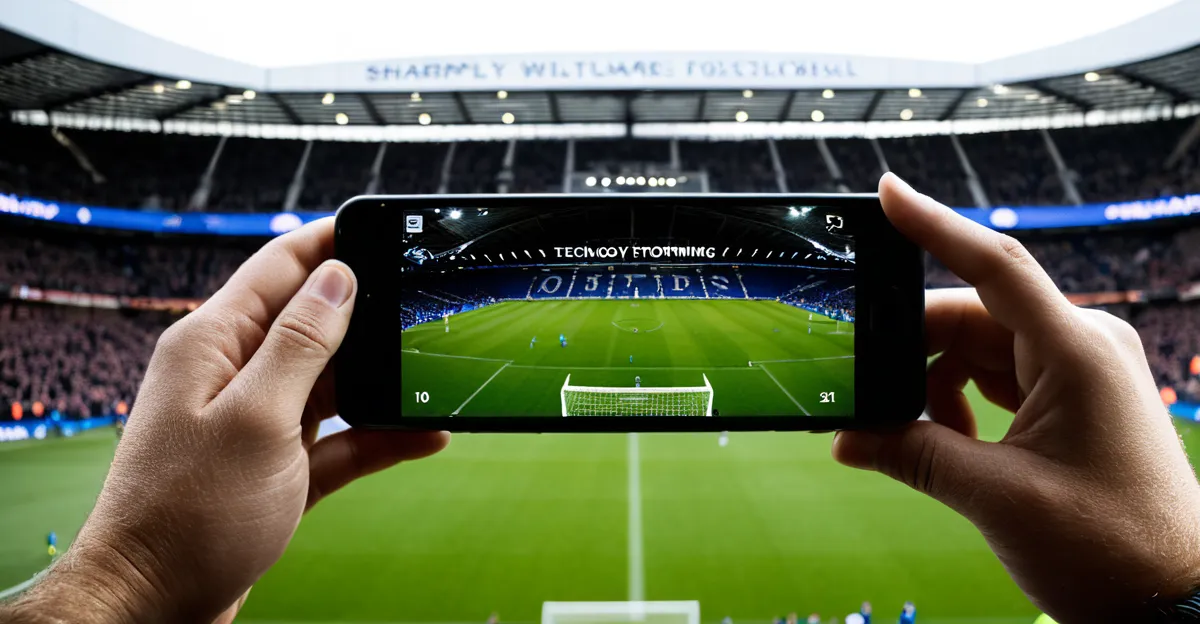The Impact of Technology on Fan Engagement in UK Football
Technology in UK football has revolutionized fan engagement, transforming how supporters experience and interact with the game. Digital innovation enables fans to connect beyond the stadium, creating a more immersive and interactive environment. From live streaming matches to real-time statistics and social media integration, technology has expanded access and deepened the emotional connection fans have with their teams.
Key technological advancements influencing UK football fans include mobile apps offering personalized content, augmented reality experiences during matches, and enhanced in-stadium Wi-Fi providing seamless internet access. These innovations have made it easier for supporters to follow games, receive instant updates, and participate in fan communities, regardless of their physical location.
This might interest you : What are the latest advancements in UK football injury prevention?
Digital platforms hold great significance in the modern football ecosystem. They serve as hubs for news, merchandise, ticket sales, and fan discussions, fostering a global network of followers. The use of data analytics and virtual engagement tools further enriches fan interaction, demonstrating how technology in UK football is essential for maintaining and growing a loyal fan base in today’s digital age.
Latest Innovations Driving Fan Interaction
Technology is transforming how UK football fans experience the game. Popular mobile apps have become essential tools for engagement, offering live updates, exclusive content, and personalized notifications that keep fans connected to their favourite teams. These apps serve as interactive hubs where supporters can access real-time statistics, player interviews, and fan polls, fostering a deeper sense of involvement even when away from the stadium.
Also to see : What Challenges Do Rising Football Talents Face in the UK?
Beyond mobile apps, virtual reality (VR) and augmented reality (AR) are revolutionizing matchday experiences. VR allows fans to immerse themselves in a stadium environment from their homes, offering 360-degree views and interactive replays that mimic being pitchside. AR supplements live broadcasts with additional layers of information projected in real time, like player stats and heatmaps, enriching the viewing experience. These innovations bring fans closer to the action and create memorable moments that go beyond traditional watching.
Interactive platforms play a vital role in connecting fans remotely, especially when physical attendance is limited. Such platforms enable live chats, fan forums, and collaborative watch parties, building strong online communities. They also incorporate gamification elements like trivia and prediction games, which promote ongoing participation and excitement. By combining mobile apps, VR, AR, and interactive platforms, the football experience becomes more accessible, engaging, and social for UK fans.
The Role of Social Media and Personalized Content
Social media has become a cornerstone for clubs aiming to strengthen fan communication and deepen engagement. Leading clubs utilize multiple social media platforms to create dynamic content strategies that resonate with diverse fan bases. These strategies prioritize interactive posts, live updates, and behind-the-scenes access that make fans feel more connected to their favorite teams.
Delivering personalized content is essential to boost fan loyalty and retention. By leveraging data analytics and user preferences, clubs tailor messages, videos, and exclusive offers directly to individual fans. This approach not only keeps fans informed but also cultivates a sense of belonging, encouraging continuous support over time.
Collaborations between clubs and influencers amplify fan engagement within digital communities. Influencers with established trust among followers help clubs expand their reach authentically. These joint efforts create shared experiences that promote passionate discussions around club activities, further enhancing the effectiveness of social media content strategies.
Enhancing Stadium Experiences Through Connectivity
In today’s sports venues, stadium technology plays a crucial role in elevating the fan experience. One of the key factors is ensuring robust stadium connectivity. Reliable and fast Wi-Fi networks allow thousands of fans to stay connected simultaneously without frustrating delays or disruptions. Improved mobile connectivity lets fans share moments in real time, access game insights, and interact with other attendees seamlessly.
In addition to connectivity, in-stadium apps have transformed how fans engage with events. These apps provide real-time stats, allowing fans to track player performance and game dynamics as the action unfolds. Furthermore, app features often include options for seat upgrades and exclusive behind-the-scenes content, making the live experience even more immersive and personalized.
Live streaming complements the in-venue atmosphere by offering fans instant replays, multiple camera angles, and interactive features right on their devices. This integration ensures that even those seated far from the action feel closely connected to every thrilling moment. Together, improved stadium Wi-Fi, innovative apps, and live streaming capabilities create an enriched, connected environment where fans enjoy the best of both live and digital engagement.
Case Studies: Leading UK Clubs Adopting Tech Solutions
Exploring how Premier League clubs leverage cutting-edge technology reveals valuable fan engagement case studies showcasing innovation. Manchester City, Liverpool, and Tottenham Hotspur each provide unique examples of how digital tools transform fan experiences.
Manchester City’s digital innovation and global fan initiatives
Manchester City leads with comprehensive digital innovation, creating platforms that connect a global fanbase. Their app offers live match updates, exclusive content, and interactive features, fostering international engagement. By integrating data analytics, City tailors content and promotions to diverse regions, boosting global reach. Additionally, City’s commitment to global fan initiatives includes virtual events and multilingual support, demonstrating a forward-thinking approach to sustaining worldwide community.
Liverpool’s use of VR/AR and personalized membership platforms
Liverpool utilizes VR/AR technology to immerse fans in matchday experiences regardless of location, allowing virtual stadium tours and interactive viewing. This technological adoption enhances emotional connection and engagement. Furthermore, Liverpool’s personalized membership platforms collect data to customize offers and communications, increasing loyalty and satisfaction. These platforms also enable seamless ticketing and merchandise options, showcasing Liverpool’s strategy to blend innovation with practical benefits for supporters.
Tottenham Hotspur’s stadium technology upgrades and fan feedback integration
Tottenham Hotspur exemplifies investment in stadium technology upgrades, such as high-speed Wi-Fi, digital screens, and mobile ordering, improving live game convenience. Importantly, they emphasize fan feedback integration by using real-time surveys and social media analytics to refine experiences. This responsive approach improves atmosphere and demonstrates Tottenham’s commitment to a fan-centric model, combining infrastructure and interaction for optimized support and enjoyment.
In summary, these Premier League clubs exemplify how embracing technology enhances engagement through diverse, innovative solutions tailored to their unique fan communities.
Measuring Success: Data, Participation, and Outcomes
Unlocking insights through numbers and experience
Understanding fan engagement statistics is crucial for clubs aiming to enhance their connection with supporters. Clubs track participation rates across digital platforms, such as apps and social media channels, to gauge how actively fans interact with content, join campaigns, or use interactive features. High participation rates often correlate with greater fan loyalty and increased revenue streams.
Clubs employ a variety of metrics to evaluate the success of their tech-driven engagement initiatives. These include the average session duration on digital platforms, click-through rates on fan campaigns, and the growth rate of online fan communities. Additionally, technology impact analysis helps reveal how innovations—like augmented reality experiences or personalized notifications—affect fan behavior and satisfaction.
Beyond numbers, the practical benefits for fans include more immersive experiences and a stronger sense of community. Meanwhile, clubs observe outcomes such as boosted merchandise sales, increased ticket purchases, and improved sponsorship appeal. Measuring these concrete results assists clubs in refining strategies to deepen fan engagement through technology.
Challenges and Considerations in Technology Adoption
Technology adoption in sports clubs comes with several challenges that require careful navigation. One significant issue is the digital divide, which refers to the gap between fans who have easy access to technology and those who do not. Addressing this digital divide is essential to ensure fan inclusivity, so that all supporters, regardless of socioeconomic background or geographical location, can enjoy enhanced fan experiences. Clubs must implement accessible technologies and consider the diverse capabilities of their fan base to avoid alienating any group.
Another critical consideration is data privacy. As clubs collect increasing amounts of personal data from fans through apps, wearable technology, and online platforms, maintaining the security and confidentiality of this information becomes paramount. Fans expect their data to be handled responsibly, and any violation can erode trust and damage the club’s reputation. Hence, clubs need robust data protection protocols and transparent privacy policies to reassure supporters that their information is safe.
Balancing tradition with innovation presents an ongoing challenge. While technology offers exciting opportunities to enhance fan engagement through virtual reality, interactive content, and personalized experiences, maintaining the historical and emotional connection fans have with their clubs is equally important. Integrating new technologies should not overshadow the core values and traditions that define the fan experience. Instead, innovation should complement and enrich these elements, creating a harmonious blend that respects the past while embracing the future.


